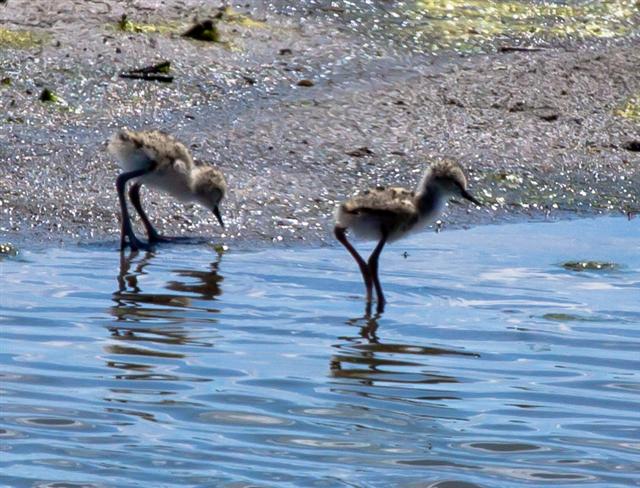
I really ought to have been house painting but it seemed ridiculous to go all that way and not take a look at what was about in the reserve. Blackbirds, Rock Doves and Monk Parakeets to welcome me and a plentiful supply of Barn Swallows and House Martins. However, crossing the footbridge it was obvious that the swifts were out in force as they were everywhere; the place was awash with these scythe-winged wonders. Of the hundreds present in the area and the reserve in general, I would calculate that at least 95% were Common but the remainder were certainly Pallid Swifts. A Little Egret made its way down the western arm of the river and a small number of Spotless Starlings were feeding and bathing at the river's edge whilst a number of House Martins were busy collecting their building materials from the exposed sandy shore, both watched over by a handful of busy House Sparrows.
+(Small).jpg) |
| Always lovely to come across Little Stints Correlimos Menudo Calidris minuta, here showing different moult stages |
 |
| Lots of Ringed Plovers Chorlitejo Grande Charadrius hiaticula to be seen |
 |
| One of four Grey Plovers Chorlito Gris Pluvialis squatarola seen on the Rio Viejo |
 |
| Black-winged Stilt Ciguenuela Comun Himantopus himantopus with two of its four chicks |


The walk back to the Laguna Grande via the Laguna Escondida produced both Sardinian Warbler and Stonechat but very little else. The Escondida was quiet with just a Moorhen and female White-headed Duck and, for its size, the Laguna Grande was all but deserted. A single Little Egret, a couple of Black-winged Stilts with four newly-hatched youngsters and a pair of Ringed Plovers. The only new birds were a Blue-headed Wagtail (Iberian race Yellow Wagtail) over-flying the water, Goldfinch and a single immature Yellow-legged Gull.
So with 36 species recorded in a couple of hours I decided to make my way and think about the painting that had not been done, confirming Thekla Lark, Serin and Bee-eaters as I made my way up the mountain track.
Birds seen:
Gadwall, Mallard, Shoveler, Red-crested Pochard, Pochard, White-headed Duck, Little Egret, Kestrel, Peregrine Falcon, Moorhen, Coot, Black-winged Stilt, Little Ringed Plover, Ringed Plover, Kentish Plover, Grey Plover, Redshank, Sanderling, Little Stint, Curlew Sandpiper, Dunlin, Yellow-legged Gull, Rock Dove, Monk Parakeet, Swift, Pallid Swift, Bee-eater, Thekla Lark, Barn Swallow, House Martin, Blue-headed Wagtail, Stonechat, Blackbird, Sardinian Warbler, Spotted Flycatcher, Spotless Starling, House Sparrow, Serin, Goldfinch
Check out the accompanying website at http://www.birdingaxarquia.weebly.com for the latest sightings, photographs and additional information.
No comments:
Post a Comment